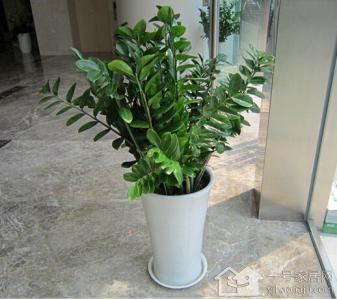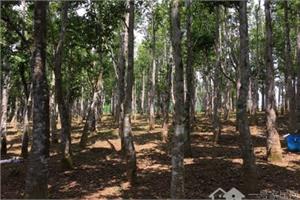Will mimosa blossom? what are the characteristics of mimosa?
Money tree is one of the most popular plants. Now we can better apply it to our daily life by learning the knowledge of money tree. Then let's take a look at the breeding methods of money tree.

Brief introduction of money Tree:
The money tree is native to the tropical (prairie) climate region with less rainfall in eastern Africa. It likes the environment where the temperature is slightly dry, half-shaded and the annual temperature change is small. It is more resistant to drought, but is afraid of cold, avoid strong light exposure, and is afraid of soil sticky weight and stagnant water in the basin soil. if the basin soil is not permeable, it is easy to cause its tuber to rot. The soil is required to be loose and fertile, well drained, rich in organic matter and acidic to slightly acidic. The sprouting power is strong, after cutting off the thick compound leaves, the tip of the tuber will soon produce new leaves.
Is the money tree poisonous?
The money tree is not poisonous. Artemisia angustifolia belongs to Araceae foliage plants, which all have unique leaf shape and leaf color, and are excellent indoor ornamental plants. Artemisia angustifolia foliage plants are succulent, herbaceous, stems and leaves with special calcium oxalate milk, which have serious irritation to the skin and stomach.
It has been reported that the tree is a highly poisonous plant, which is more severe than heartbroken grass. If its leaf juice is attached to sensitive skin, its facial features and teeth will swell; wasteland plants, birds, beasts, butterflies and reptiles are not close to it; at the same time, plants growing around them will also die. We can see that it is very poisonous. So if you find that there are other edible herbs growing in the same basin, do not use it medicinally or eat it, or you will die unknowingly. People who have this kind of plant at home should be absolutely careful not to add the soil of the money tree to other edible herbs, for its poisonous people are in the soil, otherwise it will cause endless harm.
Su Mingzhi, a lecturer in the environmental program at Tainan Social University, thought the remarks were too alarmist. He said that the money tree itself contains plant oysters. Although some physically sensitive people may cause skin and mucous membrane irritation after touching them, the premise is to destroy the plants. This phenomenon can only be caused by exposure to juice.
Money tree is a very popular indoor large bonsai plant, especially in the wider living room, study, living room display, elegant style, simple, and with southern flavor. It is a beautiful, regular and world-famous new generation of indoor foliage plants. Although it belongs to Araceae, not all Araceae plants are poisonous, so families who raise money trees need not worry too much.
The method of breeding money tree:
1. The way of reproduction. Cuttings, ramets and tissue culture can be used. If it is propagated by separating the small plants with small balls produced on the mother tuber, the large plants can only produce 2-5 plants per year, and the propagation coefficient is low and the speed is slow. The proliferation coefficient of tissue culture is not high, and can not achieve the purpose of rapid propagation. The form of leaf cuttings is easy to root, and there are 15-25 leaflets on each mature compound leaf. If it is used for reproduction, it can greatly increase the reproduction rate. Therefore, leaf insertion is the main way of propagation in production.
two。 The method of leaf insertion propagation. The mature compound leaves with strong, thick green and hypertrophy are selected as the cutting material, if you can take a leaf axis as the cuttage, it is easier to form new and larger tubers, and the effect is better. The cuttings were soaked overnight with 250mg/L indole acetic acid or naphthylacetic acid or clay mixed with petiole or leaf base. The matrix can be made of general fine sand, or peat soil, perlite and sand can be mixed in the ratio of 3 ∶ 1 ∶ 1 to make the substrate directly inserted in the peat substrate. Leave the leaves flat or upright during insertion, spray through water after insertion, and place in a shaded place to maintain the ambient temperature of 2527 ℃. Depending on the degree of dryness and wetness of the substrate, spray water on the leaf surface once or twice a day, keep the substrate slightly moist, and never be too wet, otherwise it will cause cuttings to rot and lead to cuttings failure. After 50-60 days, the petiole or the base of the petiole expanded, and then a stout new root grew on the side. After it comes out of the root, a root group is formed quickly.
3. Transplant. When the cuttings formed more than 5 roots, they were taken out from the cuttings and cultivated in the substrate basin. When the cuttings formed a certain root system, the middle of the roots gradually expanded to form spherical tubers. The tuber increases gradually. Some of the tender cuttings will die due to high temperature or poor water management, but the tubers can survive. Mature leaves and cuttings with total petioles can maintain green and vitality. A small number of tubers sprout and grow sturdy new buds in the same year.
The above is the relevant introduction of this article, I believe you have a simple understanding of this after reading it, if necessary, you can continue to pay attention to the No. 1 home network for more information.
- Prev

Introduction to cultivation methods and techniques of hydroponic hyacinth
Introduction to cultivation methods and techniques of hydroponic hyacinth
- Next

The planting method of incense wood how to distinguish between true and false?
The planting method of incense wood how to distinguish between true and false?
Related
- Wuhan Hospital Iron Tree Blooming Result Was Instantly Frightened by the Gardener Master
- Which variety of camellia is the most fragrant and best? Which one do you like best?
- What is the small blue coat, the breeding methods and matters needing attention of the succulent plant
- Dormancy time and maintenance management of succulent plants during dormancy
- Minas succulent how to raise, Minas succulent plant pictures
- What are the varieties of winter succulent plants
- How to raise succulent plants in twelve rolls? let's take a look at some experience of breeding twelve rolls.
- Attention should be paid to water control for succulent plants during dormant period (winter and summer)
- Watering experience of twelve rolls of succulent plants
- Techniques for fertilizing succulent plants. An article will let you know how to fertilize succulent plants.

